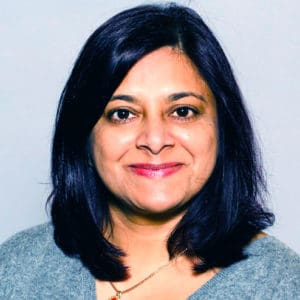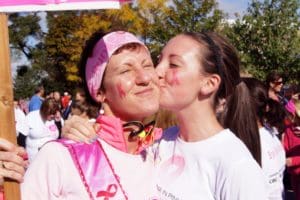By HHS Share 
Sitting in a dark room with several computer screens, staff members and technologists enter one-by-one to talk to the radiologist. They’re focused on reviewing images of all the patients’ mammograms from that day.
The low light helps Dr. Kavita Dhamanaskar and other radiologists to pick out subtle abnormalities in these complex images, whether it is plain film radiographs, ultrasound, CT scan or MRI.
In breast imaging, this involves focusing on mammogram images to detect early signs of breast cancer in both men and women.
Kavita joined Hamilton Health Sciences (HHS) 15 years ago as a staff radiologist. More recently, she took up administrative roles while continuing to provide clinical service, primarily at Juravinski Hospital.
She was appointed the medical lead of the CIBC Breast Assessment Centre (BAC) to create efficient, high-quality care for patients with breast concerns.
Going paperless to speed up operations
Kavita made several positive changes to the workflow at BAC since she started in this role. She credits much of her success to a team of passionate individuals.
“I’m a tech-driven person and I wanted the BAC to reflect that,” says Kavita.
As an example, Kavita implemented a paperless system for reporting the screening studies. This led to significant improvements in workflow, reduced errors and paper clutter that made her staff happier they no longer needed to manage the paper trail.
Ultimately, it also improved the patient experience.
“As a physical space, the BAC was designed to be a beautiful and welcoming place,” says Kavita. “I want patients to feel that entire experience as soon as they walk in the door.”
Most of the individuals coming for breast cancer screening are otherwise healthy but still have anxiety about their tests. The calming surroundings help mitigate some of their concerns.
Taking a shine to Hamilton
Kavita immigrated to Canada from India to attend fellowship in Toronto. When it was time to find a job, HHS was the first and only place to which she applied.
It was an exploration, one that was well rewarded. And she is thankful for the numerous opportunities HHS and McMaster University, where she is associate professor of radiology, offered to her growth.
“Back then, I just thought it was the right place for me to work,” says Kavita. “Hamilton is such a wonderful city with so much happening, and the health care innovation we see regularly is a big draw. This is home for me.”
Kavita is also the site chief of diagnostic imaging at Juravinski Hospital and Cancer Centre in addition to her role at the BAC.
“She works tirelessly to develop clinical guidelines based on best practices,” says Kathleen Bell, clinical manager for the BAC. “She ensures the BAC remains at the forefront of technology and expertise.”
A free bird
As the medical lead, Kavita does not take her influence for granted. She continues to network as hard as someone who’s trying to enter the field for the first time.
“I try to meet with as many people as possible, get to know them on a more personal level,” says Kavita. “Different people have different strengths and I try to understand what I’m good at and what I need others to help me with.”
Sometimes her advocacy helped get necessary technology upgrades in her department.
Her approachable personality is also on display as she interacts with various members of her team throughout the day to assess many patients that come in for exams.
Although she doesn’t feel like she’s different from anyone else, she was raised to stand out from the crowd.
“My father inspired me to be a free bird,” she says. “I was the first one in the family to consider medicine as a career and I haven’t looked back.”

 The CIBC Breast Assessment Centre’s parking lot has been closed for hospital construction. Two free spots for clients are available on Concession Street, directly in front of the Centre’s front doors. Spots are signed, Breast Assessment Centre Parking Only. For Hospital parking information and rates, click here:
The CIBC Breast Assessment Centre’s parking lot has been closed for hospital construction. Two free spots for clients are available on Concession Street, directly in front of the Centre’s front doors. Spots are signed, Breast Assessment Centre Parking Only. For Hospital parking information and rates, click here:  HAMILTON — If breast cancer awareness has a season, it is surely autumn.
HAMILTON — If breast cancer awareness has a season, it is surely autumn.
